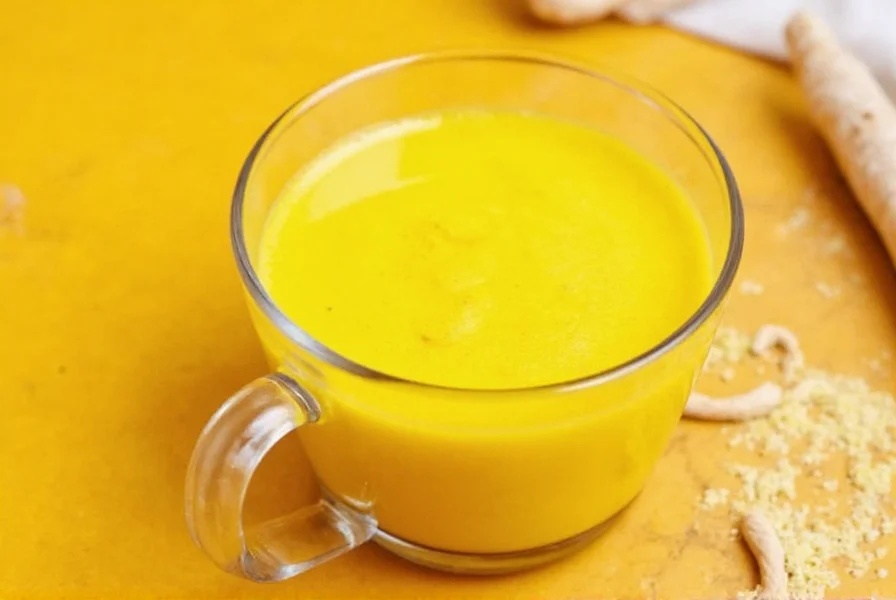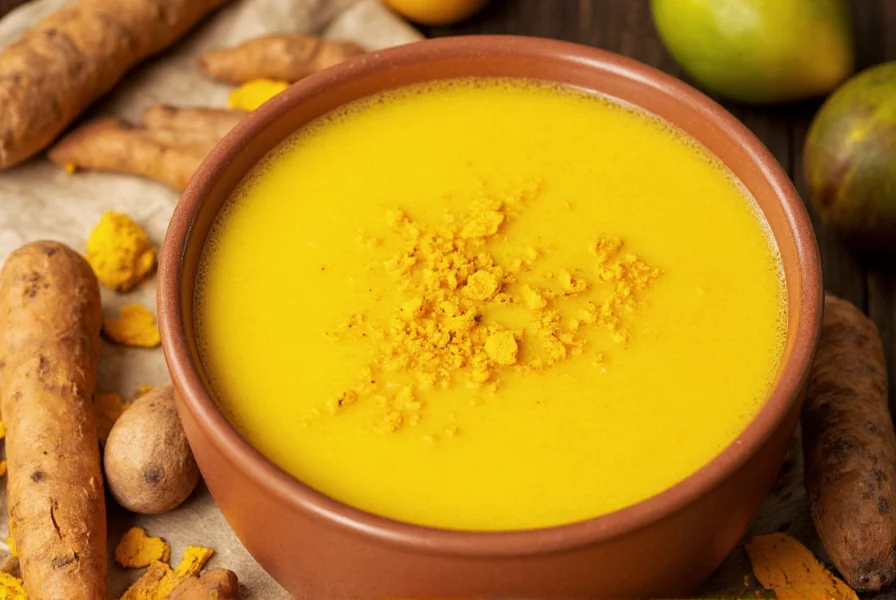For centuries, turmeric golden milk has been cherished in Ayurvedic medicine as a soothing nighttime drink. This vibrant yellow beverage combines turmeric's earthy flavor with warm milk and aromatic spices to create a comforting ritual that's gained global popularity in recent years. While often celebrated for its potential health properties, understanding what turmeric golden milk actually is—and isn't—requires examining both traditional wisdom and modern scientific evidence.
What Exactly Is Turmeric Golden Milk?
Turmeric golden milk, sometimes called haldi doodh in India, is a warm beverage blending turmeric with milk and supporting ingredients. The classic preparation includes:
- 1-2 cups of milk (dairy or plant-based)
- 1 teaspoon of turmeric powder or 1-inch fresh turmeric root
- ¼ teaspoon of black pepper (enhances curcumin absorption)
- ¼ teaspoon of cinnamon
- Small piece of fresh ginger (optional)
- Pinch of healthy fat like coconut oil or ghee
- Sweetener to taste (honey, maple syrup, or dates)
The magic happens when these ingredients combine—particularly the pairing of turmeric with black pepper and fat, which significantly increases the bioavailability of curcumin, turmeric's primary active compound.

The Science Behind Turmeric's Active Compound
Curcumin, representing about 3% of turmeric by weight, has been the subject of over 12,000 peer-reviewed studies. Research indicates curcumin may:
| Potential Benefit | Current Evidence Level | Important Considerations |
|---|---|---|
| Anti-inflammatory effects | Strong in vitro and animal studies | Human studies show modest effects; requires high bioavailability |
| Antioxidant properties | Well-documented in laboratory settings | Real-world impact depends on absorption and dosage |
| Mood support | Preliminary human studies | Small sample sizes; more research needed |
| Joint comfort | Moderate clinical evidence | Effects typically seen with standardized extracts, not dietary amounts |
Crucially, plain turmeric has extremely low bioavailability—less than 1% absorption rate. The traditional golden milk preparation addresses this through three key elements:
- Fat inclusion: Curcumin is fat-soluble, so adding ghee or coconut oil improves absorption
- Black pepper: Piperine increases curcumin absorption by up to 2,000%
- Heat: Gentle warming helps release curcumin from the turmeric matrix
Traditional Preparation Method
Creating authentic turmeric golden milk follows these evidence-based steps:
- Heat 1-2 cups of milk (dairy or unsweetened almond/coconut) until steaming but not boiling
- Add 1 tsp turmeric, ¼ tsp cinnamon, small ginger slice, and pinch of black pepper
- Simmer gently for 5-10 minutes to activate compounds
- Stir in ½ tsp coconut oil or ghee for enhanced curcumin absorption
- Strain and add natural sweetener if desired
For optimal results when making homemade turmeric golden milk, use fresh turmeric root when possible—it contains higher curcuminoid levels than powdered forms. The traditional evening consumption timing aligns with Ayurvedic principles of supporting nighttime rest and overnight healing processes.

Evidence-Based Benefits vs. Common Misconceptions
While turmeric golden milk has gained popularity as a "miracle drink," it's essential to separate evidence-based benefits from exaggerated claims:
Supported by emerging research:
- May support healthy inflammatory response when properly formulated
- Could contribute to antioxidant intake as part of balanced diet
- Warm milk beverage may support relaxation before bedtime
Common misconceptions requiring clarification:
- "Cures" specific diseases - No evidence supports turmeric golden milk as treatment for medical conditions
- Immediate results - Any potential benefits require consistent consumption over time
- Equal to clinical curcumin supplements - Dietary amounts provide significantly less curcumin than therapeutic doses used in studies
Safety Considerations and Who Should Exercise Caution
Turmeric golden milk is generally safe for most people when consumed in culinary amounts. However, certain individuals should consult healthcare providers before regular consumption:
- People taking blood thinners (turmeric may enhance effects)
- Those with gallbladder issues (turmeric may stimulate bile production)
- Individuals scheduled for surgery (discontinue 2 weeks prior)
- People with iron deficiency (high turmeric intake may affect absorption)
Pregnant women can typically enjoy occasional turmeric golden milk as a beverage, but should avoid medicinal quantities. The appropriate daily turmeric intake in golden milk ranges from ¼ to 1 teaspoon—significantly less than therapeutic supplement doses.
Variations for Different Dietary Needs
Modern adaptations maintain the core principles while accommodating various preferences:
- Vegan golden milk: Use coconut or almond milk with coconut oil instead of ghee
- Lower-sugar version: Skip sweeteners or use stevia; the natural milk sweetness often suffices
- Enhanced absorption formula: Add a small amount of healthy fat and always include black pepper
- Cold preparation: Blend ingredients for a golden milk smoothie (less traditional but maintains benefits)
For those exploring turmeric golden milk for inflammation support, consistency matters more than intensity—daily moderate consumption aligns better with traditional use and current evidence than occasional large doses.
Integrating Turmeric Golden Milk Into Your Wellness Routine
The most effective approach to enjoying turmeric golden milk follows these principles:
- Consume in the evening to potentially support restful sleep
- Make it part of a balanced diet rather than relying on it as a standalone solution
- Use high-quality ingredients—organic turmeric provides better curcumin content
- Be patient—any potential benefits develop gradually with consistent use
- Combine with other healthy lifestyle practices for comprehensive wellness
When prepared properly with attention to absorption-enhancing ingredients, turmeric golden milk can be a valuable component of a holistic wellness approach. Its enduring popularity across cultures speaks to both its comforting nature and potential health-supporting properties when understood within realistic expectations.











 浙公网安备
33010002000092号
浙公网安备
33010002000092号 浙B2-20120091-4
浙B2-20120091-4